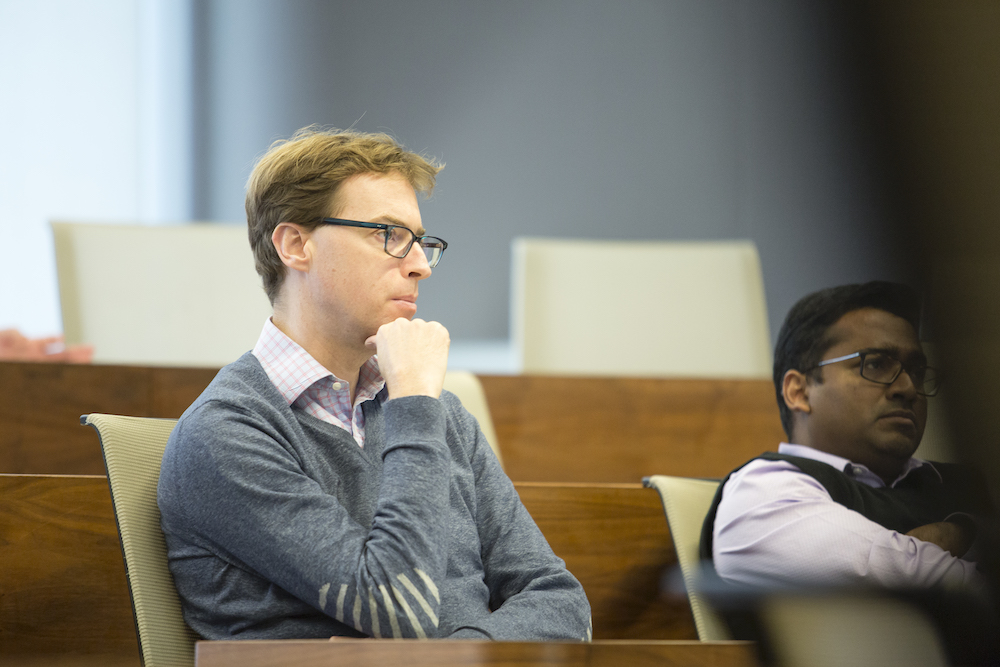Student Spotlight:
Emmanuel Murray LeClair
PhD Student, Economics, Western University

Understanding how industries respond to challenges like climate change is essential for effective policy design. A complex relationship exists when balancing environmental policy, energy choice, emissions reduction, and economic outcomes. Emmanuel’s recent research demonstrates three important insights:
- That familiar policies such as carbon taxes are more effective than clean technology subsidies at reducing industrial emissions;
- That the direct reduction in industrial emissions from carbon taxes outweighs carbon leakage, especially when there are pre-existing barriers to trade; and,
- That natural gas pipelines cannot always allocate supply to match demand, particularly during extreme weather conditions.
Emmanuel describes the main conclusions from his research.
Cost-Effective Reduction of Carbon Emissions in Energy-Intensive Industries
One of the main papers in my PhD dissertation investigates how to clean up steel manufacturing in India. The Indian steel industry is the world's second-largest steel market after China and is a major source of global emissions. In India, coal is used to produce 70% of the country’s steel, in contrast to steel manufactured in Europe and North America, which relies on cleaner energy such as electricity and natural gas.
My research highlights the challenges underlying the clean-up of this high-emitting sector. The lack of critical infrastructure, specifically natural gas pipelines in the regions producing steel is the primary factor preventing the clean-up. It locks factories into using old, inefficient, and difficult to replace coal-based technologies.
Several policies can be developed to address emissions from the steel sector including clean technology subsidies. This research studies whether clean technology subsidies can alleviate technology lock-in, encouraging the transition away from coal. The results are discouraging. Subsidizing cleaner technologies is ineffective because it primarily benefits smaller, less emission-intensive factories. Moreover, it encourages free riding from plants that would adopt cleaner technology regardless of the subsidy. Meanwhile, high-emission plants do not find it profitable to change practices even with a subsidy on clean technology, and technology lock-in remains.
So, what works? It turns out that a carbon tax is more effective at reducing emissions. Carbon taxes encourage a shift in industry output from dirtier to cleaner plants. This is especially important for the steel industry in India. Here's why: in the steel industry, plants compete to produce steel used in almost every sector of the economy. As a carbon tax is implemented, coal-based plants face higher costs simply because coal releases more carbon emissions. As a result, coal-intensive companies pass through a larger fraction of the tax to consumers. Consumers, therefore, see a higher price for steel coming from these coal-based plants, and seek alternative steel suppliers who offer lower prices. Cleaner plants have small cost increases, so a carbon tax makes them more competitive. They benefit from increased demand, as output is reallocated from dirty to clean plants. Overall, through reallocation across companies, we can reduce emissions by a significant 50% in the Indian steel industry using a carbon tax while maintaining 93% of the industry's total output.
A crucial insight gained from this research extends beyond the specific industries and regions studied. It highlights that certain firms can thrive in the face of rising fuel prices. While it's commonly assumed that higher fuel costs have adverse consequences for the most emission-intensive firms, my findings indicate that energy-efficient and cleaner competitors may, in fact, benefit as fuel prices increase as production is reallocated from energy-intensive to energy-efficient firms.
How Much Should We be Concerned with Carbon Leakage?
Another paper of my PhD dissertation studies the issue of carbon leakage. Carbon leakage occurs when greenhouse gas emissions shift from regions with stricter regulations to those with fewer regulations. Carbon leakage is at the center of climate change policy debates. As more developed regions implement carbon pricing policies, such as the federal carbon tax in Canada and the European emission trading system, there is a growing concern that emission-intensive industries will move to regions with no emission regulations.
Focusing on British Columbia's carbon tax introduced in 2008, I find that the tax didn't trigger a significant emission increase in other, unregulated provinces. To put it in numbers, for every 1% drop in BC's emissions, there was only a small 0.06% increase in other provinces. The explanation for the missing leakage is that it isn’t easy for businesses to compete across provincial borders due to pre-existing internal trade barriers. Trade barriers make it difficult for consumers to change suppliers, which maintained the competitiveness of BC businesses in the aftermath of the tax.
Can Natural Gas Pipelines Handle Weather-Induced Demand Shocks?
The last chapter of my PhD dissertation examines the efficiency of natural gas pipeline networks. In this work (co-authored with Yanyou Chen and Adam Wyonzek at the University of Toronto), we investigate if natural gas pipeline networks are capable of handling large increases in supply from unexpected periods of high demand such as those that occur during extreme weather conditions.
We show that the organization of pipeline networks can lead to situations in which gas does not flow to meet demand due to various constraints. This is because pipeline capacity is allocated through long-term contracts.
Shippers use these contracts to reserve pipeline capacity prior to a pipeline's construction. They are frequently needed to finance large pipeline projects. However, long-term contracts can cause situations in which a pipeline cannot meet demand, not because of physical constraints, but because of contractual ones. This happens when consumers who own long-term capacity are not the ones who face the increase in demand.
In this context, we are interested in the role of a secondary market unique to the U.S., where shippers can lease and rent capacity in daily auctions. During extreme weather conditions like the cold wave in Texas (February 2021) and California (February-March 2019), shippers facing the demand increase rent pipeline capacity in this secondary market from less affected shippers. However, most shippers involved in this secondary market are marketers. And here's the twist – each market has a dominant marketer. These dominant marketers use their capacity to flow natural gas, which they sell to consumers and retailers who need it. This market concentration incentivizes dominant marketers to strategically capacity to raise prices.
Thus, there is a trade-off: while market power is concerning, the existence of a secondary market improves the allocation of natural gas. We argue that the Canadian pipeline system would benefit from a similar secondary market for capacity as unanticipated demand shocks become more common.
